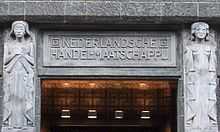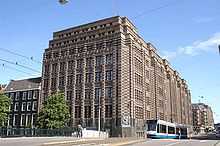Netherlands Trading Society

The Netherlands Trading Society (Dutch: Nederlandsche Handel-Maatschappij or NHM) was a Dutch trading company established in 1824 by King Willem I of the Netherlands to promote and develop trade, shipping and agriculture. For the next 140 years the NHM developed a large international branch network and increasingly engaged in banking operations, and subsequently would become one of the primary ancestors of ABN AMRO.
History

The NHM was a private company which issued publicly traded shares and according to the king, the NHM would act to leverage economic activity and encourage the development of national wealth. However in practice it came down to expanding existing trade, by gathering data and searching for new markets as well as financing industry and shipping. Its close association with Dutch government meant it played an important role in the development of trade between the Netherlands and the Dutch East Indies.[1] Its former headquarters in De Bazel in Amsterdam houses the Amsterdam Archives today.[2]
The NHM is sometimes called the successor of the Dutch East India Company, as it was also a private company that issued shares and financed trade with the Dutch East Indies. The establishment of the NHM could probably be seen as an attempt to bring new impetus to trade with the Dutch East Indies after the depression of the years of French domination (1795–1814) and the final collapse of the Dutch East India Company two decades earlier.
The NHM financing of trade and shipping led to the development of a network of branches which increasingly engaged in financing and banking operations. The network extended throughout South East Asia and on the trade routes between the Netherlands and the Dutch East Indies and the NHM continued to extend its network into the 20th century. It lost a number of its branches when the Indonesian government nationalised them in 1960 to form a new locally owned bank, but by then had branches in many other parts of the world. The NHM continued to developed more and more banking and financing operations with its branch network and it went on to became one of the primary ancestors of ABN AMRO bank when in 1964 it merged with the Dutch Twentsche Bank to form Algemene Bank Nederland (ABN).
Time line
_HET_GEBOUW_DER_HANDELMAATSCHAPPIJ.jpg)

- 1824: King Willem I created the Nederlandsche Handel-Maatschappij (NHM) by Royal Decree to revive trade between the Netherlands and the Netherlands East Indies.
- 1826: NHM opened an office in Batavia (Jakarta).
- 1858: NHM opened a branch in Singapore.
- 1870: NHM extended its activities to include banking.
- 1888: NHM opened a branch in Penang.
- 1889: NHM opened a branch in Hong Kong.
- 1920: NHM opened branches in Bombay (Mumbai) and Calcutta (Kolkata) primarily to work with clients in the diamond business.
- 1926: NHM opened a branch in Jeddah, Saudi Arabia. Know later as the Saudi Hollandi Bank it was the first, and until 1948 the only, commercial bank in the Kingdom. The branch existed to serve the needs of Indonesian Muslims coming to perform Hajj, the pilgrimage to Mecca.
- 1941: NHM opened an agency in New York City.
- 1948: NHM opened a branch in Karachi to become the first foreign bank to receive a banking license from the new government of Pakistan.
- 1949: NHM acquired De Surinaamsche Bank.
- 1951: NHM opened branches in Mombasa, (Kenya), and Dar-es-Salaam, (Tanganyika).
- 1960: The Indonesian government nationalized NHM's local operations and formed a new bank, Bank Ekspor Impor Indonesia, later Bank Mandiri.
- 1963: NHM set up its Malaysian head office in Kuala Lumpur.
- 1964: NHM merged with De Twentsche Bank to form Algemene Bank Nederland (ABN).
References
- ↑ (Dutch) explanation of building in Amsterdam Archives
- ↑ Amsterdam Archives
External links
- Dutch_East_Indies in 1911 Encyclopædia Britannica
- King Willem I in 1911 Encyclopædia Britannica